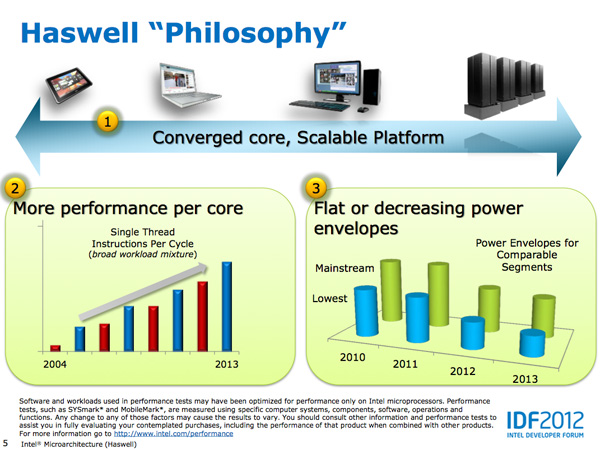Intel's Haswell Architecture Analyzed: Building a New PC and a New Intel
by Anand Lal Shimpi on October 5, 2012 2:45 AM ESTPrioritizing ILP
Intel has held the single threaded performance crown for years now, but the why is really quite easy to understand: it has prioritized extracting instruction level parallelism with every generation. Couple that with the fact that every two years we see a "new" microprocessor architecture from Intel and there's a recipe for some good old evolutionary gains. The table below shows the increase in size of some major data structures inside Intel's architectures for every tock since Conroe:
| Intel Core Architecture Buffer Sizes | ||||||
| Conroe | Nehalem | Sandy Bridge | Haswell | |||
| Out-of-order Window | 96 | 128 | 168 | 192 | ||
| In-flight Loads | 32 | 48 | 64 | 72 | ||
| In-flight Stores | 20 | 32 | 36 | 42 | ||
| Scheduler Entries | 32 | 36 | 54 | 60 | ||
| Integer Register File | N/A | N/A | 160 | 168 | ||
| FP Register File | N/A | N/A | 144 | 168 | ||
| Allocation Queue | ? | 28/thread | 28/thread | 56 | ||
Increasing the OoO window allows the execution units to extract more parallelism and thus improve single threaded performance. Each generation Intel is simply dedicating additional transistors to increasing these structures and thus better feeding the beast.
This isn't rocket science, but it is enabled by Intel's clockwork fab execution. Designers can count on another 30% die area to work with every 2 years, so every 2 years they increase the size of these structures without worrying about ballooning the die. The beauty of evolutionary improvements like this is that when viewed over the long term they look downright revolutionary. Comparing Haswell to Conroe, the OoO scheduling window has grown by a factor of 2x, despite generation to generation gains of only 14 - 33%.











245 Comments
View All Comments
Spunjji - Thursday, October 18, 2012 - link
Fuckwit.nirmalv - Sunday, October 7, 2012 - link
Anandtech being a hardware site,its more inclined to keenly flow hardware devices with new architecture and innovations. iphone brings in1, A new A7 chip design and a novel 3 core graphics core
2, A new 3 microphone parabolic sound receiving design(which likely will become the new standard)
3, A new sim tray design(which will also likely become the new standard)
4, New sony BSI stacked sensor (the 13 mpx version will likely be the rage next year).
5, The first time that we have a 32 nm LTE chip which will give all day usage.
6, New thinner screen with incorporated touch panel and 100 % RGB
I am not sure about samsung but can anyone enlighten me about S3's technical achievements?
nirmalv - Sunday, October 7, 2012 - link
Sorry make that a 28 nm LTE basebandcenthar - Sunday, October 7, 2012 - link
99.998% of iPhone users just don't care about that. Really they don't.Geeks like me who do, are too damn smart to sell our souls to the such a god damned, locked down and closed system to even bother to care.
Magik_Breezy - Sunday, October 14, 2012 - link
2nd thatSpunjji - Thursday, October 18, 2012 - link
3rdCaptainDoug - Tuesday, October 23, 2012 - link
4th,solipsism - Tuesday, October 9, 2012 - link
Of course a company that releases one device per product category per year as well as one with the greatest mindshare is going to have more articles.But what happens when you add up all Samsung phones against all Apple phones in a given year?
What happens when you don't count the small blogs that only detail a small aspect of a secretive product but count the total words to get a better feel for the effort spent per company's market segment?
I bet you'll find that AT spends a lot more time covering Samsung's phones than Apple's.
Spunjji - Thursday, October 18, 2012 - link
This. I generally trust their editorial, but the focus on Apple prevails. One just has to read accordingly.Kepe - Friday, October 5, 2012 - link
Also look at any other Apple product review. They are all ridiculously in-depth with analysis about almost every single component in the product. Macbook Pro with Retina Display got 18 pages, the 3rd gen iPad got 21 pages. Don't get me wrong, I like a proper review with everything analyzed, but it's only the Apple products that get these huge reviews. But compared to those massive Apple reviews, it's like all other products are just glanced over in a hurry. The new Razer Blade got 9 pages. Asus Transformer Pad Infinity got 8 pages.